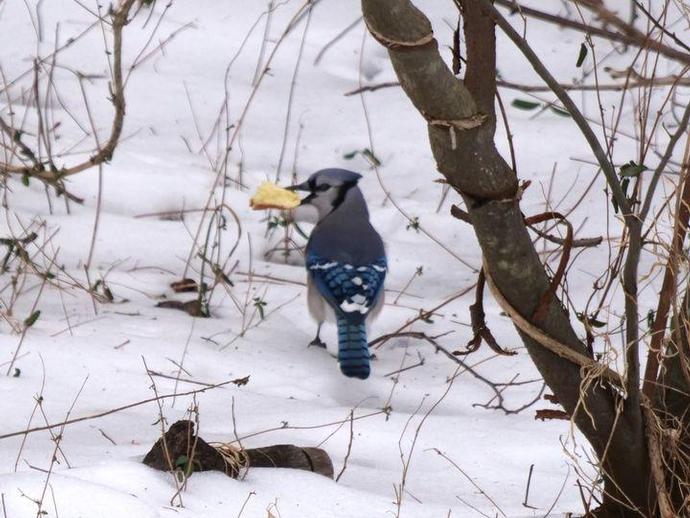January 28, 2022
Ben here with the Friday edition of #BenInNature presented by our friends at Carter Bank & Trust!
The blue jay (Cyanocitta cristata), seen here absconding with a scrap from my compost heap, gets a bad rap. Too many backyard birders hate blue jays, especially when they come swooping into the feeder and scatter all the other birds. Even John James Audubon wrote of the blue jay, "Who could imagine that selfishness, duplicity, and malice should form the moral accompaniments of so much physical perfection!" That's a pretty harsh assessment of a bird.
Sure, blue jays do sometimes scare other birds away from the feeder, and on rare occasions they've been known to plunder eggs and even nestlings from the nests of other birds. However, we owe a lot to these remarkable birds. In fact, North American forests would look pretty different if not for the blue jay!
Like squirrels, blue jays cache nuts for the winter, and they tend to cache a lot of them since they're pretty large birds. However, also like squirrels, they never find a large number of the nuts that they hide away, which leads to these tree nuts germinating and growing in the spring. Since blue jays travel a lot farther than squirrels do, they help spread trees far and wide, and it's believed that blue jays played a major role in expanding the range of North American forests when the glaciers retreated at the end of the ice age!
Of course, there's a common belief that blue jays are "mean" to other birds. In fact, blue jays can provide a major benefit to other bird species. They will chase away predatory birds like hawks and owls, and if a predator enters a blue jay's territory, it will let out an alarm call that other birds recognize. Consider it nature's emergency siren.
The next time a blue jay shows up to raid your bird feeder, don't shoo it away; instead, thank it for its service!
ABOUT #BenInNature
Social distancing can be difficult, but it presents a great opportunity to become reacquainted with nature. In this series of posts, Administrator of Science Ben Williams ventures outdoors to record a snapshot of the unique sights that can be found in the natural world. New updates are posted Monday - Friday, with previous posts highlighted on the weekends. This series of posts is made possible thanks to the support of VMNH Corporate Partner Carter Bank & Trust (www.cbtcares.com).
NATURE PHOTO IDENTIFICATIONS
If you discover something in nature that you would like help identifying, be sure to message us right here on Facebook with a picture (please include location and date of picture) and we'll have our experts help you identify it!

 Hours & Admissions
Hours & Admissions Directions
Directions

